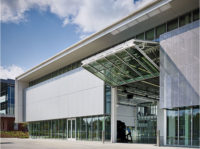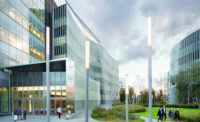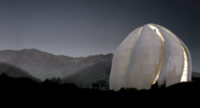San Diego
It's not every day that a client asks an architect to make room for a dirt yard in its plans for a high-tech facility. But, then, the diesel technology department at San Diego Miramar College, a public two-year school in the northern portion of the county, is not your everyday client. This one-of-a-kind program trains students to service and maintain diesel-powered trucks, tractors, and heavy equipment, using cutting-edge technologies for component analysis and real-time problem solving. A dirt testing yard is their proving ground. 'Students use it to practice operating the machinery they've worked on,' explains Dan Wilkie, the program's chair.
From the outset, the client's requests reflected its specialized mission and a desire to use state-of-the-art facilities to attract top students and industry partners. In addition to updated classroom and hands-on teaching spaces'and, of course, the testing yard'the department wanted the option to host training sessions for industry partners, which contribute equipment and other resources; an indoor area to accommodate a dynamometer (a large testing bed that simulates real-world road conditions to permit assessment of vehicle performance at highway speeds); adequate parking and circulation for vehicles and equipment; and enhanced security indoors and out. 'Obviously this is a highly unusual project type,' says Imirzian, founder of Marlene Imirzian & Associates Architects, with offices in Phoenix and nearby Escondido, California. 'Our multidisciplinary team collaborated closely with the college from the start so we could meet our objectives and avoid cost overruns.' Her diverse portfolio of higher education, commercial, and civic projects in the region made her well qualified for this juggling act, and ultimately she delivered HDATT under budget'an impressive feat, given that the cost of the dynamometer and other major equipment upgrades were included in the public funding package.
The complex's layout and circulation grew organically from a wish to improve the program's visibility and to provide better connections to the campus proper. When Imirzian first visited the 4.6-acre site, largely just a dirt yard then, she glimpsed opportunity where others saw only a neglected facility. Now the revamped and smaller testing yard sits at the center of the complex, and a simple, gracious raised terrace, accessible via a major campus walkway, welcomes the entire college to drop by and witness the action firsthand. 'It's like having a monster truck rally every day on campus,' she deadpans. The test yard also acts as a natural barrier between pedestrians entering the terrace from the northwest and the large vehicles and equipment that access the teaching areas from the east. A perforated metal gate slides shut to close off the complex after school hours while still permitting views throughout.
Imirzian originally considered designing one large multi-use building. But the vastly different mechanical requirements of the program elements, coupled with the space needed for vehicles to circulate through the site, led to a three-building scheme instead. These structures comprise 17,500 square feet and form a lively mini-campus around the testing yard and terrace. At the dynamometer building, trucks being tested inside are visible through the glazed facade that looks onto the yard, offering another glimpse of big machines in motion. Lectures, classroom instruction, and computer labs take place in the building just south of the terrace, and across from it is the complex's signature space, a bright, airy six-bay vehicle shop where most hands-on instruction occurs. It's illuminated by daylight that pours in from an array of tubular skylights in the 29-foot ceiling. Fluorescent overhead fixtures add more light when needed and, in a first for the school, allow classes to be taught at night. Huge ceiling fans and natural ventilation keep the interior comfortable without air-conditioning in San Diego's forgiving climate. Worktables and storage lockers are mounted on wheels for easy reconfiguration or can be lifted and moved by an overhead crane. The concrete floor is coated in white epoxy paint''a pain to keep clean,' says Wilkie, though he admits that it reflects light well for working underneath vehicle carriages. The back wall, clad in plate steel, has recessed I-beams that serve as open electrical chases, which adapt handily to rapidly changing technologies and instrumentation. Faculty offices line a side wall and oversee the shop, so instructors are never more than a few steps away for quick consultations or floor visits.
All three buildings share a material language of glass, steel, concrete, and CMUs, with balanced, harmonious proportions determined in part by siting and function. Full-height glass walls for the vehicle shop and dynamometer create view corridors inside and out, while windows for the classroom are placed high and low so that the middle of the walls can serve as pinup space. Much of the steel has a brown, high-performance coating, and light-tan CMUs have bricklike proportions, lending the complex an appropriately industrial air that doesn't feel chilly or clinical.
Campuses are always a bit of an architectural hodgepodge, and, right now, HDATT stands as a breed apart and a cut above its context of unremarkable stucco buildings. It's refreshing to see design of such high quality at a public two-year college, where tight budgets and low bidders are often blamed for turning these campuses into aesthetic backwaters. At the moment, Miramar College is undergoing an ambitious construction effort that will include a science building by Imirzian (across from the transportation technology facility) to be completed in 2015. But, no matter how these other projects turn out, HDATT is poised to endure. With virtually no similar examples to follow, Imirzian conceived an imaginative and finely crafted complex that captures the aspirations of a forward-thinking educational program, meeting the community's needs today while helping them envision what they might become tomorrow.
PeopleClient: San Diego Community College District Owner: San Diego Community College District Architect: Personnel in architect's firm who should receive special credit: Engineers: Structural Engineer: Eric Lehmkuhl, PE KPFF Consulting Engineers Inc. Mechanical Engineer: Joe Kilcoyne, PE, SC Consulting Engineers Inc. Electrical Engineer: Syska Hennessy Group Inc. Consultant(s): Other: Cost Consultant: Graham Anderson, Campbell-Anderson & Associates Inc. General contractor: Photographer(s): Construction cost: $9.85 million Size: 17,500 square feet (gross) Completion date: September 2013 |
ProductsStructural system Exterior cladding Metal/glass curtain wall: Superior Doors: Aluminum & Glass Overhead Doors Moisture barrier: W.R. Meadows MEL-ROL waterproofing membrane Other: Windows Glazing Skylights: Solatube tubular skylights Doors Wood doors: VT Industries Overhead coiling door: The Cookson Company Sectional Glazed aluminum overhead doors: Superior Door Hardware Closers: LCN Exit devices: Von Duprin Pulls: Ives Interior finishes Suspension grid: Armstrong Prelude XL Paints and stains: Glidden Solid surfacing: Corian Floor and wall tile: restrooms - DalTile keystone mosaic Lighting Downlights: kurt versen Exterior: Hydrel, Kenall, Philips Dimming System or other lighting controls: Lutron Plumbing Electric water coolers: Haws Add any additional building components or special equipment that made a significant contribution to this project: |















